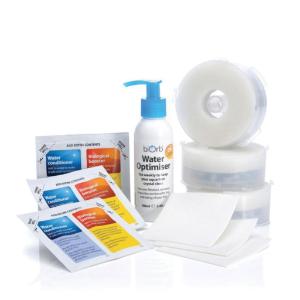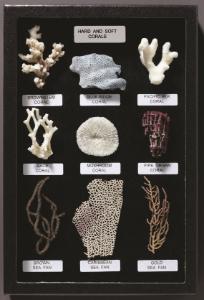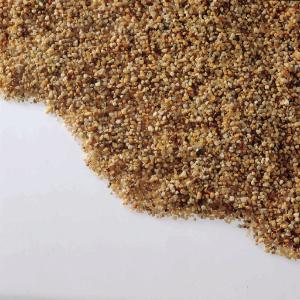The Blue Planet: A Guide to Conserving Marine Ecosystems, Plus Activity
All Grade Levels
Jump to Activity
Current events indicate that one of the most pressing issues our planet faces today is the conservation of marine ecosystems. From majestic coral reefs to the battle against ocean pollution, these vital ecosystems need our attention and protection. Your lesson plans can help students explore the importance of conserving marine ecosystems, including coral reefs, ocean pollution, and the role of marine protected areas. You can also engage students and enrich their understanding and appreciation of ecosystems with hands-on science activities like those described in this post.
We’ve compiled the facts below to ensure you don’t face any great barriers to getting started.
The Precious Coral Reefs
Coral reefs are often called the "rainforests of the sea" because of their incredible biodiversity. They support countless species of marine life, protect coastlines from erosion, and contribute to local economies through tourism and fisheries. However, coral reefs are under serious threat due to factors like climate change, overfishing, and pollution. Teaching your students about the importance of coral reefs can inspire them to become future stewards of these fragile ecosystems.
These underwater rainforests teem with life, housing a mind-boggling variety of species that rivals the most diverse ecosystems on land. In fact, healthy coral reefs provide habitat for over 1 million aquatic species.1 As students explore coral reef facts, they may be intrigued to discover that the richness of these ecosystems stems from their symbiotic relationships. They will be introduced to mutualism, a common ecological interaction where two or more species benefit, as coral polyps and algae demonstrate.
Coral Polyps and Algae: Coral reefs are built by tiny creatures called coral polyps. These polyps live mutualistically with photosynthetic algae (aka zooxanthellae). The coral provides a protected home and nutrients to the algae, while the algae, in turn, supply the coral with energy through photosynthesis. This relationship is behind the vibrant colors and magnificent growth of coral reefs.
Ocean Acidification and Coral Bleaching: While coral reefs are truly awe-inspiring, their chances of survival are becoming increasingly bleak. Rising levels of atmospheric carbon dioxide (CO2) are absorbed by the oceans, leading to ocean acidification (decrease in the pH). Between 1950 and 2020, the average pH of the ocean surface fell from approximately 8.15 to 8.05.2 This acidification weakens the calcium carbonate structures that corals rely on for their skeletons.
Recent science news headlines also warn of elevated sea temperatures due to climate change causing coral bleaching3, a phenomenon in which the coral expels its algae, leading to the death of the reefs. The global sea surface temperature has increased at an average rate of 0.14oF per decade (Fig. 1). NOAA scientists point out that it takes massive heat energy to raise Earth’s average yearly surface temperature by even a tiny amount. The global average surface temperature increase might seem small, but it means a significant increase in accumulated heat. The temperature has been consistently higher during the past three decades than at any other time since reliable records began in 1880.
Figure 1. Average Global Sea Surface Temperature, 1880–2020
Source: EPA: Climate Change Indicators: Sea Surface Temperatures
The Battle Against Ocean Pollution
Plastics, chemicals, and other pollutants harm marine life and disrupt ecosystems. Teaching your students the science of ocean pollution raises awareness and empowers them to take action in their daily lives, such as reducing plastic waste and supporting conservation efforts.
Plastic Pollution: The proliferation of plastic in our oceans is a global crisis. Every year, 11 million metric tons of plastics enter our ocean on top of the estimated 200 million metric tons that currently circulate.4 Plastics break down into smaller particles known as microplastics, which marine life ingest. These particles can disrupt the endocrine systems of marine organisms and accumulate in the food chain, ultimately affecting human health.
Chemical Pollution: Chemical pollutants from industries, agriculture, and urban runoff (nonpoint source) contaminate marine ecosystems. In fact, 80% of pollution to the marine environment comes from the land.5 Nonpoint source pollution includes septic tanks, cars, trucks, boats, and more significant sources, such as farms, ranches, and forest areas. Students may be surprised to learn that millions of motor vehicles drop small amounts of oil daily onto roads and parking lots, much of which makes its way to the sea.
Not surprisingly, these pollutants can disrupt marine organisms' reproductive and metabolic processes. Pesticides, heavy metals, and oil spills harm marine life, leading to toxic accumulations and widespread ecological damage.
Marine Protected Areas: Nature's Sanctuaries
Marine protected areas (MPAs) are essential for preserving biodiversity and providing a haven for marine life to thrive. Teaching your students about MPAs can inspire them to advocate for their creation and maintenance.
Students may have already visited an MPA and didn’t even realize it! MPAs are in central California, the Florida Keys, Acadia, Cape Cod, the Virgin Islands, the Gulf Coast wetland, the Olympic Coast, Thunder Bay, and many more locations! There are currently 437 MPAs in the U.S. The International Union for the Conservation of Nature (IUCN) defines a protected area as “a clearly defined geographical space, recognized, dedicated and managed, through legal or other effective means, to achieve the long-term conservation of nature with associated ecosystem services and cultural values.”
Hands-on Science Activity: Building Miniature Ecosystems
A great way to engage students in marine conservation is by having them create miniature ecosystems. This activity demonstrates the complexity and fragility of ecosystems while allowing students to appreciate their beauty; plus, it’s a lot of fun! Here's how to do it:
biOrb® CLASSIC Aquaria is a simple starter aquarium. You can be up and running in no time; everything you need to get started is in one box. It’s perfect for shrimp, fish, and decorations. Each biOrb® CLASSIC aquarium comes with a tank, a 12V transformer, ceramic media, an air pump and air stone, water conditioners, and a light. It really is a case of just adding water and fish. Get a biOrb® Decor Set to bring the aquarium to life using the Flower Garden with vibrant designs and colors paired with quality materials.
Or create your own ecosystem with classroom supplies.
Materials:
- A large aquarium or fish tank
- Sand or gravel
- Rocks or coral decorations
- Plastic coral replicas or craft materials
- Water
- Aquarium lighting (if available)
- Sea-themed books or educational materials
Steps:
- Start by filling the aquarium with water and adding sand or gravel to create a substrate.
- Place rocks and coral decorations strategically to mimic a natural reef structure.
- Have students create their own miniature coral replicas using craft materials. They can research different coral species and their shapes, colors, and sizes for accuracy.
- Submerge the crafted corals in the tank, positioning them like they would find in a natural reef.
- Provide proper lighting, if possible, to simulate the conditions of a healthy coral reef.
- Add living specimens such as Pond Snails, Sea Urchin, Tetra Fish, or others suitable for your aquarium. You may find these Living Material Care Guides useful.
Throughout the activity, discuss the importance of ecosystems and coral reefs, their threats, and what can be done to protect them. Encourage students to research and document the different species they've included in their ecosystems and discuss their ecological roles.
By incorporating these lessons and hands-on activities into your lesson plan, you can inspire the next generation to become responsible stewards of our oceans and work towards conserving these vital marine ecosystems. Your students can take pride in their ability to make a difference in preserving our planet.
1. US EPA: Basic Information about Coral Reefs
2. Terhaar, Jens; Frölicher, Thomas L.; Joos, Fortunat (2023). "Ocean acidification in emission-driven temperature stabilization scenarios: the role of TCRE and non-CO2 greenhouse gases.”
3. Reuters: Florida's rising water temperatures raise concerns for health of coral reefs, scientists say. Jul. 2023.
4. Ocean Conservancy: The Problem with Plastics.
5. National Oceanic and Atmospheric Administration: What is the biggest source of pollution in the ocean?
Recommended Products
[StartProductBlock]

biOrb® Maintenance Materials
Keep your biOrb® working like new. Maintenance for the inside and outside.
[EndProductBlock]
[StartProductBlock]

Hard and Soft Corals Riker Mount
Attractive, sealed exhibit to introduce students to colonial organisms' diversity. Features delicate and exotic varieties.
[EndProductBlock]
[StartProductBlock]

Ward's® Aquarium Gravel
Decorative gravel is essential for maintaining your aquarium, acting as a substrate for the bacteria cultures necessary for a healthy tank.
[EndProductBlock]
